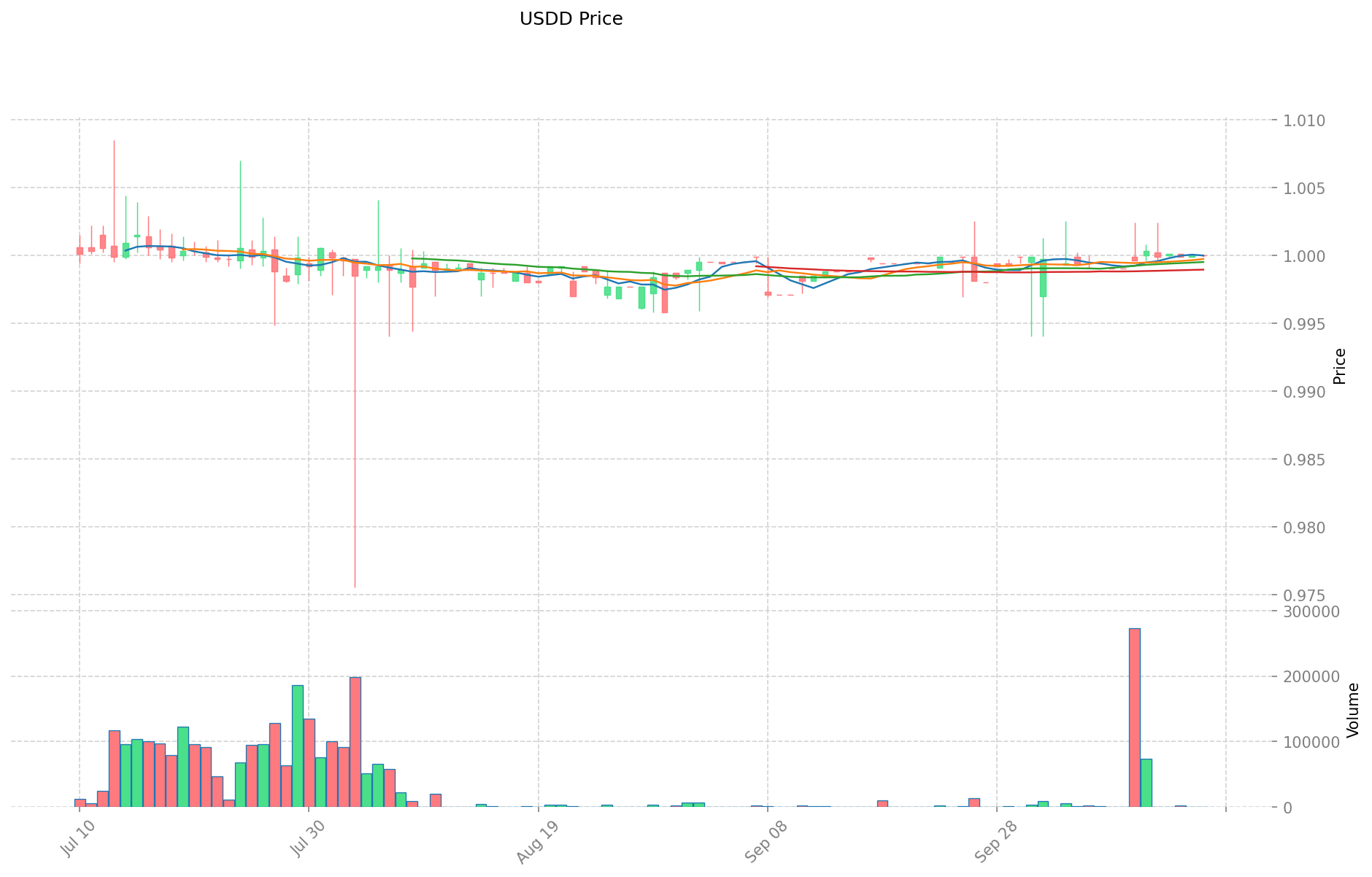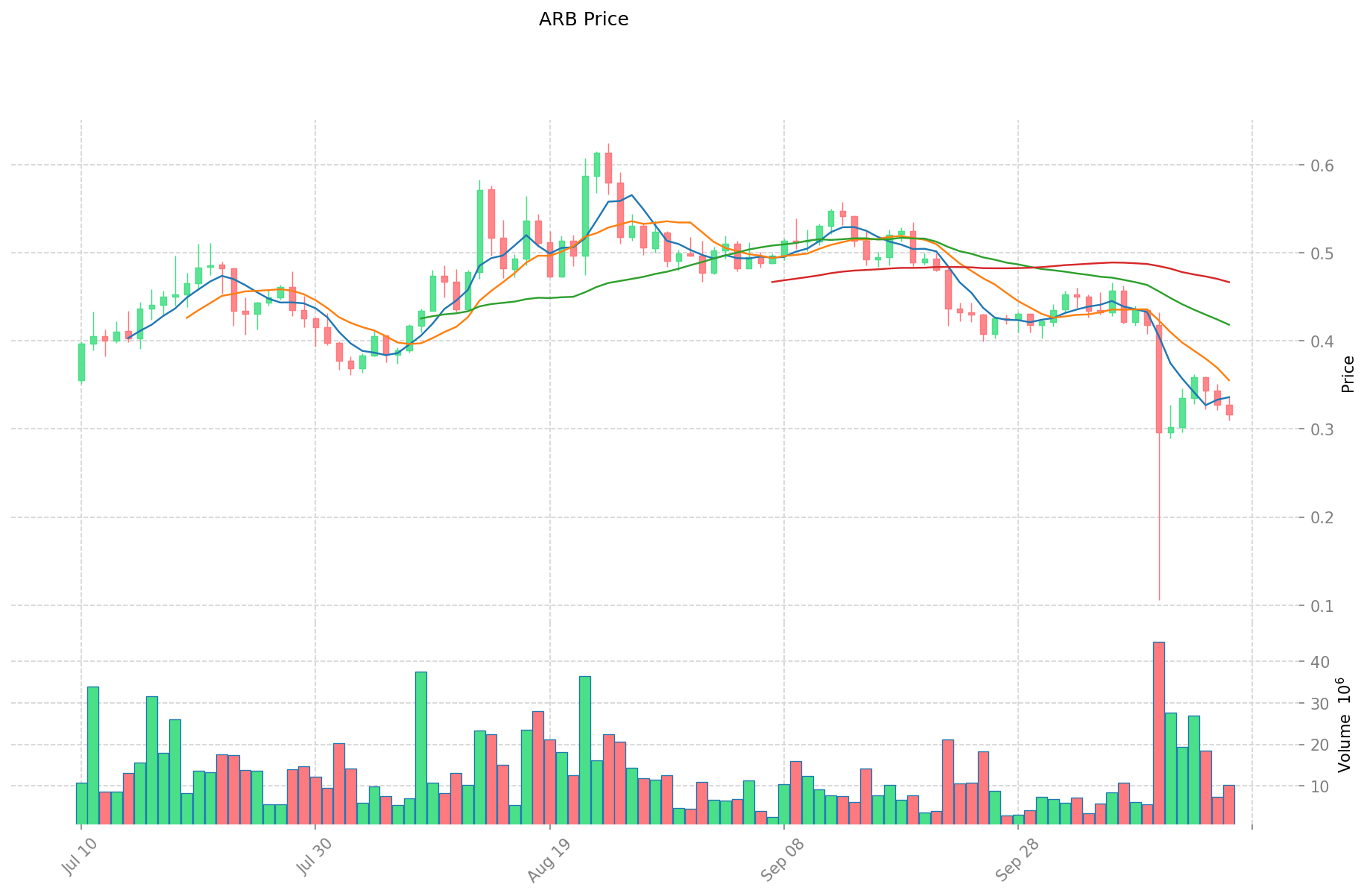USDD vs ARB: Comparing Stablecoin Stability and Ecosystem Growth in the DeFi Space
Introduction: Investment Comparison of USDD vs ARB
In the cryptocurrency market, the comparison between USDD vs ARB has always been a topic that investors cannot avoid. The two not only show significant differences in market cap ranking, application scenarios, and price performance, but also represent different positioning in crypto assets.
USDD (USDD): Since its launch in 2022, it has gained market recognition for its stable price and diverse use cases as a cryptocurrency issued by Wave Field DAO Reserve.
ARB (ARB): Introduced in 2023, it has been hailed as the governance token for the Arbitrum ecosystem, which is an Ethereum extension solution enabling high-throughput, low-cost smart contracts.
This article will comprehensively analyze the investment value comparison between USDD vs ARB, focusing on historical price trends, supply mechanisms, institutional adoption, technological ecosystems, and future predictions, attempting to answer the question that investors care about most:
"Which is the better buy right now?"
I. Price History Comparison and Current Market Status
USDD and ARB Historical Price Trends
- 2023: USDD maintained relative stability due to its stablecoin nature, with minor fluctuations around the $1 peg.
- 2023: ARB launched in March and experienced significant volatility, reaching an all-time high of $4 shortly after launch.
- Comparative analysis: During the 2023-2025 market cycle, USDD remained relatively stable near $1, while ARB experienced a substantial decline from its all-time high of $4 to its current price.
Current Market Situation (2025-10-17)
- USDD current price: $1.00
- ARB current price: $0.3158
- 24-hour trading volume: USDD $180,492,952 vs ARB $3,304,863,473
- Market Sentiment Index (Fear & Greed Index): 28 (Fear)
Click to view real-time prices:
- View USDD current price Market Price
- View ARB current price Market Price


II. Key Factors Affecting Investment Value of USDD vs ARB
Supply Mechanism Comparison (Tokenomics)
- USDD: Core value lies in its strong regulatory compliance and authoritative backing as TRON's native stablecoin
- ARB: Total supply of 10 billion tokens with 5.403 billion in circulation, functioning as a governance token for the Arbitrum network
- 📌 Historical pattern: ARB's value is more susceptible to adoption rates and market conditions, while USDD aims for stability
Institutional Adoption and Market Applications
- Institutional holdings: USDD benefits from its positioning within TRON's ecosystem including USD1 and TRX Vault, creating synergistic effects
- Enterprise adoption: ARB's value proposition strengthens when mainstream users and major dApps utilize Arbitrum as their backend
- Regulatory attitudes: USDD emphasizes compliance as a core value component, potentially providing regulatory advantages
Technical Development and Ecosystem Building
- USDD development: Functions as TRON's native decentralized component within its broader stablecoin ecosystem
- ARB development: Built on Optimistic Rollup technology to process transactions off-chain while anchoring security to Ethereum mainnet
- Ecosystem comparison: ARB has demonstrated stronger L2 business metrics since launch compared to competitors like OP, suggesting greater competitive strength in the Layer 2 ecosystem
Macroeconomic Factors and Market Cycles
- Performance in inflationary environments: Not explicitly covered in the sources
- Macroeconomic monetary policy: ARB price predictions vary widely ($1-$2 mid-term, potentially over $20 long-term) depending on adoption rates and market conditions
- Geopolitical factors: ARB's value is heavily influenced by network growth, developer activity and broader crypto market trends
III. Price Prediction for 2025-2030: USDD vs ARB
Short-term Prediction (2025)
- USDD: Conservative $0.58-$1.00 | Optimistic $1.00-$1.04
- ARB: Conservative $0.25-$0.32 | Optimistic $0.32-$0.33
Mid-term Prediction (2027)
- USDD may enter a growth phase, with prices expected in the range of $0.95-$1.17
- ARB may enter a consolidation phase, with prices expected in the range of $0.27-$0.41
- Key drivers: Institutional capital inflow, ETF developments, ecosystem growth
Long-term Prediction (2030)
- USDD: Base scenario $1.42-$1.72 | Optimistic scenario $1.72+
- ARB: Base scenario $0.45-$0.53 | Optimistic scenario $0.53+
Disclaimer
USDD:
| 年份 | 预测最高价 | 预测平均价格 | 预测最低价 | 涨跌幅 |
|---|---|---|---|---|
| 2025 | 1.04 | 1 | 0.58 | 0 |
| 2026 | 1.1016 | 1.02 | 0.8568 | 2 |
| 2027 | 1.16688 | 1.0608 | 0.95472 | 6 |
| 2028 | 1.6262064 | 1.11384 | 0.8131032 | 11 |
| 2029 | 1.465924824 | 1.3700232 | 1.150819488 | 37 |
| 2030 | 1.71574855452 | 1.417974012 | 0.7798857066 | 41 |
ARB:
| 年份 | 预测最高价 | 预测平均价格 | 预测最低价 | 涨跌幅 |
|---|---|---|---|---|
| 2025 | 0.332115 | 0.3163 | 0.246714 | 0 |
| 2026 | 0.463616725 | 0.3242075 | 0.256123925 | 2 |
| 2027 | 0.405729475875 | 0.3939121125 | 0.271799357625 | 24 |
| 2028 | 0.479784953025 | 0.3998207941875 | 0.363836922710625 | 26 |
| 2029 | 0.466191046022625 | 0.43980287360625 | 0.224299465539187 | 39 |
| 2030 | 0.530006442982891 | 0.452996959814437 | 0.353337628655261 | 43 |
IV. Investment Strategy Comparison: USDD vs ARB
Long-term vs Short-term Investment Strategy
- USDD: Suitable for investors seeking stability and a hedge against market volatility
- ARB: Suitable for investors focusing on ecosystem potential and Layer 2 growth
Risk Management and Asset Allocation
- Conservative investors: USDD: 70% vs ARB: 30%
- Aggressive investors: USDD: 40% vs ARB: 60%
- Hedging tools: Stablecoin allocation, options, cross-currency portfolio
V. Potential Risk Comparison
Market Risk
- USDD: De-pegging risk, liquidity fluctuations
- ARB: High volatility, susceptible to market sentiment
Technical Risk
- USDD: Scalability, network stability
- ARB: Centralization concerns, potential security vulnerabilities
Regulatory Risk
- Global regulatory policies may have differing impacts on stablecoins and Layer 2 solutions
VI. Conclusion: Which Is the Better Buy?
📌 Investment Value Summary:
- USDD advantages: Stability, regulatory compliance, TRON ecosystem integration
- ARB advantages: Layer 2 growth potential, governance token for Arbitrum network
✅ Investment Advice:
- Novice investors: Consider a higher allocation to USDD for stability
- Experienced investors: Balanced approach with both USDD and ARB based on risk tolerance
- Institutional investors: Strategic allocation to both, with ARB for ecosystem exposure
⚠️ Risk Warning: The cryptocurrency market is highly volatile. This article does not constitute investment advice. None
VII. FAQ
Q1: What are the main differences between USDD and ARB? A: USDD is a stablecoin aiming to maintain a $1 peg, while ARB is a governance token for the Arbitrum network. USDD offers stability, while ARB provides exposure to Layer 2 ecosystem growth.
Q2: Which token has shown better price performance historically? A: USDD has maintained relative stability around $1 due to its stablecoin nature. ARB, launched in 2023, experienced higher volatility, reaching an all-time high of $4 before declining to its current price.
Q3: How do their supply mechanisms differ? A: USDD's supply is managed to maintain its peg to $1. ARB has a total supply of 10 billion tokens, with 5.403 billion currently in circulation.
Q4: What are the key factors affecting their investment value? A: For USDD: regulatory compliance, stability, and TRON ecosystem integration. For ARB: Arbitrum network adoption, Layer 2 growth, and overall crypto market trends.
Q5: Which token is better for long-term vs short-term investment? A: USDD is suitable for investors seeking stability and a hedge against market volatility. ARB is better for those focusing on ecosystem potential and Layer 2 growth.
Q6: What are the potential risks for each token? A: USDD risks include de-pegging and liquidity fluctuations. ARB faces high volatility and is susceptible to market sentiment. Both have technical and regulatory risks.
Q7: How should investors allocate their portfolio between USDD and ARB? A: Conservative investors might consider 70% USDD and 30% ARB, while aggressive investors could opt for 40% USDD and 60% ARB. The exact allocation should be based on individual risk tolerance and investment goals.
Share
Content